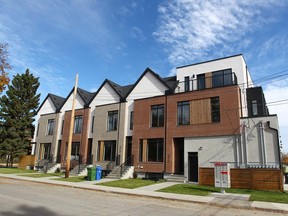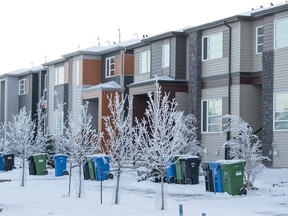Calgary is less than one month from public hearings on proposed citywide upzoning.
Article content
With a public hearing on Calgary’s proposed city-wide rezoning less than a month away, public scrutiny over the proposal is ramping up by the day.
Advertisement 2
Article content
If approved by city council, the base zoning in Calgary would be adjusted to allow forms of low-density housing other than single-family homes in neighbourhood where this isn’t already the case.
Article content
It is hoped such a change would make more land available for the construction of semi-detached homes (a.k.a. duplexes and triplexes) and townhomes, allowing for gentle increases in density.
There are so many facets of this topic to explore and when I broached the subject last week, there were a few things I didn’t get to that are worthy of discussion.
I’d also like to acknowledge readers for sending in their thoughts and chatting about the subject on social media. Some of that feedback inspired what’s to come below.

A few people highlighted concerns about accommodations for parking.
Article content
Advertisement 3
Article content
You can already observe successful parking strategies in parts of Calgary that were previously upzoned, where the housing stock is already beginning to evolve — the most common (and logical, in my humble opinion) being attached garages at ground level with the rest of the dwelling built above it.
If residents choose not to park in their private spaces and insist on using curbside parking instead, that’s a problem of their own making.
We may also occasionally overestimate how many people will actually need to park a vehicle. This is worth noting as the highest-density developments are planned to be on or near main streets with good access to transit and other transportation modes.

One of the more alarming messages that landed in my inbox suggested the proposed changes would turn Calgary into a giant slum.
Advertisement 4
Article content
Hyperbole aside, the upzoning proposal doesn’t include apartment buildings.
Even with semi-detached dwellings and row houses, plus secondary suites where applicable, there are maximum limits on lot coverage and minimum suite sizes.
It’s not as if someone can cram as many units as they want into whatever is being built.
Another reader commented about the esthetics of rowhouses, after seeing an image of such a building embedded within my commentary on our website last week.
All I can say is … beauty is in the eye of the beholder, no matter what kind of houses are being built. Some will look great, and others will be pedestrian or worse. Something you or I dislike is something someone else might appreciate.

Concerns also remain about upzoning affecting the character of a neighbourhood. And on a related note, one reader objected to my highlighting of Garrison Woods last week.
Advertisement 5
Article content
That is a fair criticism, at least partly, as Garrison Woods was mostly developed from the ground up, although I was trying to demonstrate how you can have a mix of housing types without it being ugly.
Let me repeat the exercise using the neighbourhoods on either side of Sunnyside CTrain station.
Looking at the City of Calgary’s development map, you’ll notice the base zoning in those areas had already been changed to allow for development of dwellings other than single-family homes.
Despite this, those areas still contain mostly single-family homes, and some of the new builds there continue to be … single-family homes.
Mixed in with those are duplexes, triplexes and town homes as high as three or four stories. There are even low-rise apartment buildings.
Advertisement 6
Article content
And everything is fine.
Yes, the entire neighbourhood has changed subtly over the last two decades — perhaps less subtly along its major streets and near the CTrain, where taller buildings have cropped up with time — but a lot has endured and the neighbourhood’s character is still thriving, with the area feeling as neighbourly, welcoming and liveable as always.
The same story could be told of other places like Crescent Heights, Bridgeland, Inglewood, and more.
And while past performance is not an indicator of future outcomes, the generally positive experience with rezoning in central Calgary neighbourhoods bodes well for the entire city.
Article content